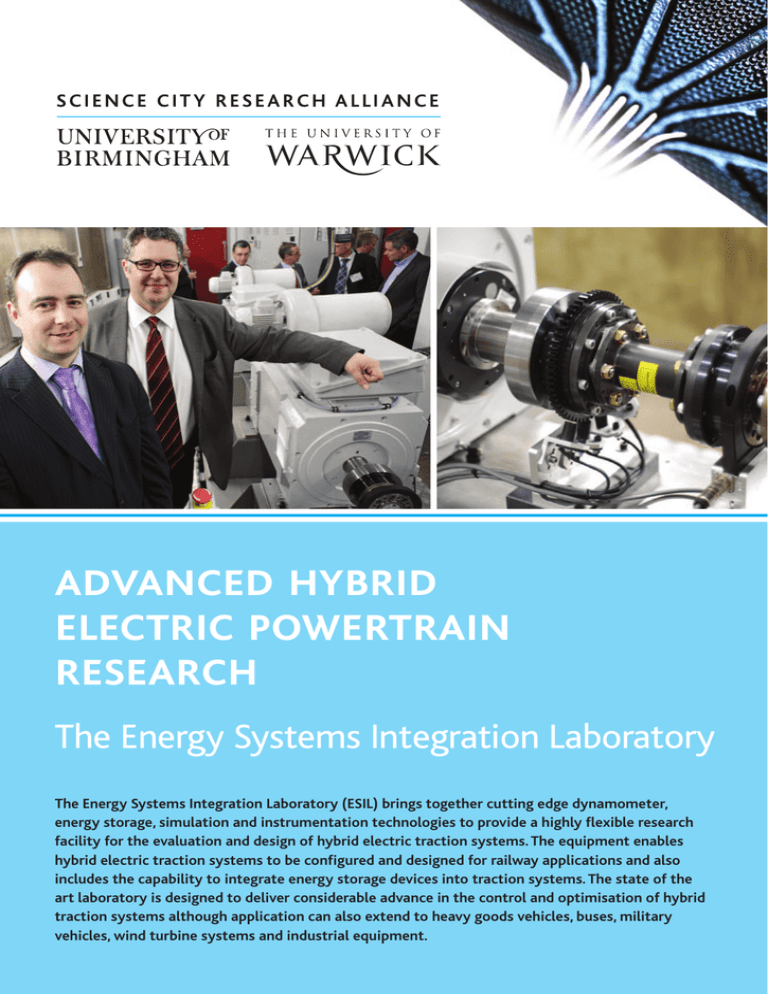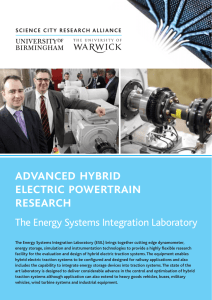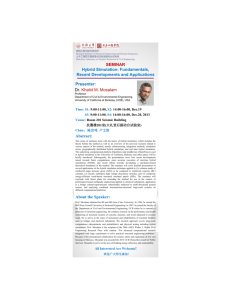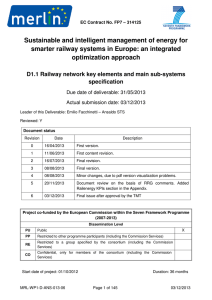advanced hybrid electric powertrain research The Energy Systems Integration Laboratory
advertisement

advanced hybrid electric powertrain research The Energy Systems Integration Laboratory The Energy Systems Integration Laboratory (ESIL) brings together cutting edge dynamometer, energy storage, simulation and instrumentation technologies to provide a highly flexible research facility for the evaluation and design of hybrid electric traction systems. The equipment enables hybrid electric traction systems to be configured and designed for railway applications and also includes the capability to integrate energy storage devices into traction systems. The state of the art laboratory is designed to deliver considerable advance in the control and optimisation of hybrid traction systems although application can also extend to heavy goods vehicles, buses, military vehicles, wind turbine systems and industrial equipment. OVERVIEW This back to back test facility is used to investigate hybrid electric drive trains. The equipment consists of two mechanically connected induction machines, capable of being controlled independently of each other. One of the machines (load machine) is controlled to apply a suitable dynamic load to the other machine (drive machine) powered by the hybrid energy source such that realistic duty cycles can be controlled by an external PC based system, while the primary machine torque and speed control can be provided by the same PC based system. The facility has provision to interface with the DC link of the drive machine’s power converter in order to supply energy to the machine from external energy storage devices, and to recharge when the primary machine is regenerating. It is also possible to independently monitor all voltages, currents and temperatures of all power converters used in the test facility, together with machine speed and torque. WORLD LEADING EXPERTISE IN HYBRID TRACTION SYSTEMS AND RAILWAY APPLICATIONS The ESIL research is led by Dr Stuart Hillmansen, an expert in vehicle simulators and hybrid traction systems, and Professor Clive Roberts who has expertise in condition monitoring, asset management and systems engineering. Both are leading academics of the Birmingham Centre for Railway Research and Education which brings together a multidisciplinary team from across the University of Birmingham to tackle fundamental railway engineering problems. The team actively engages with industry and other universities through Rail Research UK Association and international partners. KEY FEATURES Dynamometer rig: • Dynamic load simulation • +/- 110kW power flow • Torque (<700Nm) • Speed (<3000rpm) Battery cycler: For testing and evaluating life cycle performance of battery packs and other DC power devices, including fuel cells and super or ultra capacitors: 3 phase; 415Vrms with options; 213Arms, 50 or 60Hz 440Vdc; 530Adc; 125kW source; 170 kW sink System evaluation and simulation: Hybrid energy system evaluation: • Control strategy evaluation • Power circulation • Duty cycle simulation Energy storage device evaluation DC/DC converter evaluation Data acquisition hardware and software for capturing data such as temperature, current, voltage, frequency etc. The lab has full ethernet capability which will enable the test facilities to be synchronised with other labs, such as the SCRA Vehicle Energy Facility at the University of Warwick. For further information and enquiries, including access to the facilities, research consultancy or collaboration: Dr Sam Hardy - Business Engagement Manager for the Science City Research Alliance Energy Efficiency project. Email: samuel.a.hardy@warwick.ac.uk Tel: + 44 (0) 24 7657 5497 Mobile: + 44 (0) 7824 540793 www.railway.bham.ac.uk www.birminghamsciencecity.co.uk/research-alliance The Energy Systems Integrated laboratory is part of the Science City Energy Efficiency and Demand project funded by Advantage West Midlands and the European Regional Development Fund. The project is part of a wider investment in research infrastructure of the West Midlands region, which unites the Universities of Birmingham and Warwick in the newly-formed Science City Research Alliance.








